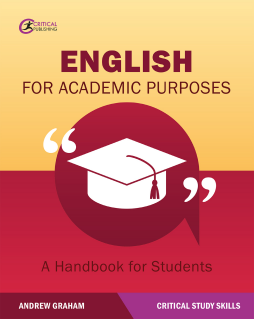
Additional Information
Book Details
Abstract
Useful as a course book or as a self-study guide, this text is essential reading for all international students studying for a British qualification at university. It provides a clear guide to the areas that need to be considered in order to research and produce a well presented and cohesive piece of academic writing. The steps outlined, and the language used, are accessible, and graded to a level that steadily introduces new writing concepts to students studying for a degree in a second or additional language. In particular it covers planning, conducting research, critical thinking, structuring an essay, use of sources and referencing, and feedback and revision.
Andrew Graham is the award leader for an International Foundation Programme (IFP) run in collaboration between Chengdu University of Technology, China and Oxford Brookes University, UK. Andrew has worked closely with ESL students for over 8 years, teaching a range of modules that centre around academic research and writing, group-work, presentation skills, and critical thinking. He has worked on syllabus design across these modules and created a variety of resources that are appropriate for international students studying for a British qualification.
Table of Contents
| Section Title | Page | Action | Price |
|---|---|---|---|
| Cover | Cover | ||
| Half Title | i | ||
| Title | iii | ||
| Series Page | iv | ||
| Acknowledgements | v | ||
| Meet the author | vi | ||
| Contents | vii | ||
| Foreword | ix | ||
| Introduction | x | ||
| Glossary | xii | ||
| Unit 01 – Academic writing overview | 1 | ||
| 1.1 – What is academic writing? | 1 | ||
| 1.2 – Features of academic writing | 6 | ||
| Unit 02 – Understanding the topic and planning | 13 | ||
| 2.1 – Understanding assessment tasks | 13 | ||
| 2.2 – Creating new ideas | 17 | ||
| 2.3 – Planning an academic paper | 19 | ||
| Unit 03 – Academic arguments | 24 | ||
| 3.1 – Arguments in writing | 24 | ||
| 3.2 – Critical thinking | 29 | ||
| 3.3 – Identifying fallacies | 31 | ||
| Unit 04 – Structure: introductions | 38 | ||
| 4.1 – General statements | 38 | ||
| 4.2 – Thesis statements and essay maps | 41 | ||
| Unit 05 – Structure: main body paragraphs | 46 | ||
| 5.1 – Topic sentences | 46 | ||
| 5.2 – Presenting your ideas | 50 | ||
| 5.3 – Concluding sentences | 55 | ||
| 5.4 – Cohesion | 57 | ||
| Unit 06 – Structure: conclusions | 61 | ||
| 6.1 – Elements of a conclusion | 61 | ||
| 6.2 – Final ideas | 64 | ||
| Unit 07 – Finding evidence | 67 | ||
| 7.1 – Types of sources | 67 | ||
| 7.2 – Types of evidence | 70 | ||
| 7.3 – Conducting research | 74 | ||
| 7.4 – Reliability | 78 | ||
| Unit 08 – Reading techniques | 89 | ||
| 8.1 – Reading comprehension | 89 | ||
| 8.2 – Skimming and scanning | 92 | ||
| 8.3 – SQ3R | 94 | ||
| Unit 09 – Using others’ ideas | 97 | ||
| 9.1 – Preparation | 97 | ||
| 9.2 – Paraphrasing | 101 | ||
| 9.3 – Summarising | 106 | ||
| 9.4 – Translations | 109 | ||
| 9.5 – Quotations | 112 | ||
| 9.6 – Reporting verbs | 115 | ||
| Unit 10 – Referencing | 119 | ||
| 10.1 – Understanding referencing | 119 | ||
| 10.2 – Citations | 123 | ||
| 10.3 – Reference lists | 128 | ||
| Unit 11 – Revision techniques | 136 | ||
| 11.1 – Feedback | 136 | ||
| 11.2 – Improving cohesion | 141 | ||
| 11.3 – Proofreading | 147 | ||
| 11.4 – Writing checklist | 152 | ||
| Unit 12 – Formatting | 155 | ||
| 12.1 – Margins, font and spacing | 155 | ||
| 12.2 – Cover page and appendices | 159 | ||
| Exercises | 163 | ||
| Unit 01 – Academic writing overview | 163 | ||
| Unit 02 – Understanding the topic and planning | 167 | ||
| Unit 03 – Academic arguments | 174 | ||
| Unit 04 – Structure: introductions | 176 | ||
| Unit 05 – Structure: main body paragraphs | 183 | ||
| Unit 06 – Structure: conclusion | 190 | ||
| Unit 07 – Finding evidence | 193 | ||
| Unit 08 – Reading techniques | 199 | ||
| Unit 09 – Using others’ ideas | 204 | ||
| Unit 10 – Referencing | 212 | ||
| Unit 11 – Revision techniques | 215 | ||
| Unit 12 – Formatting | 218 | ||
| References | 219 |
